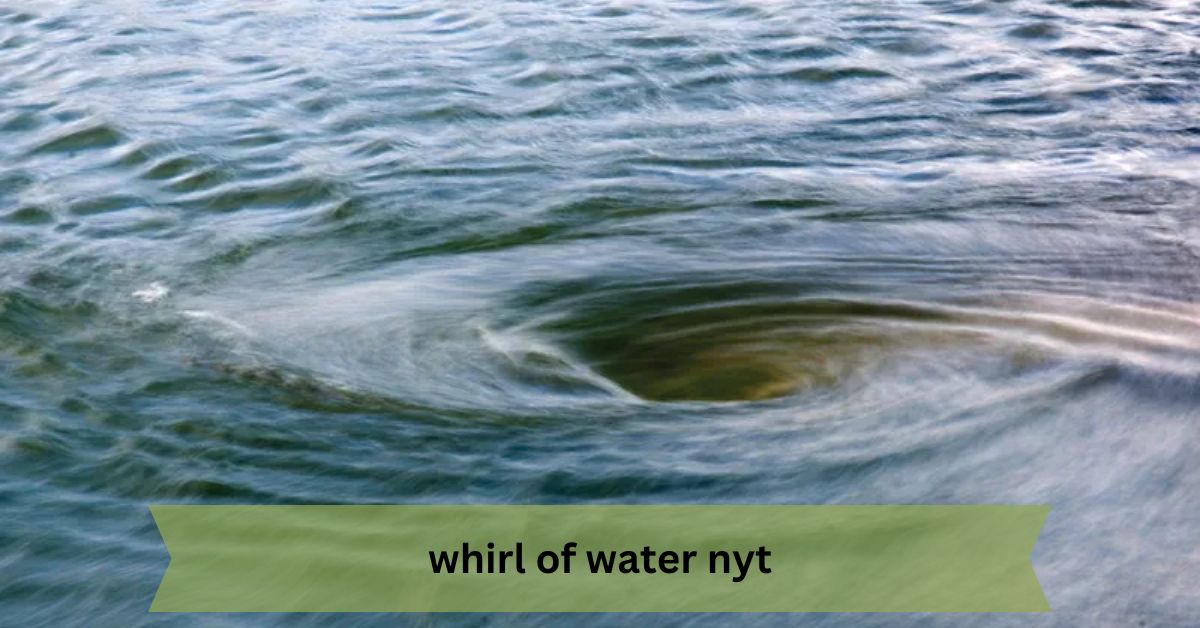Crossword puzzles have long been a beloved pastime for many, challenging our minds and keeping us entertained. Among the myriad of clues, there’s one that often stumps solvers: the “whirl of water NYT”
In this article, we’ll dive deep into the significance of the “whirl of water nyt” clue in the context of the NYT crossword, explain what an eddy is, and explore why this specific clue has caught the attention of so many puzzle enthusiasts.
What is the Whirl of Water Nyt in Crossword Puzzles?
The phrase “whirl of water” refers to a small circular movement in water, often seen in rivers or oceans. The crossword clue asks solvers to think of a word associated with this phenomenon, and the most common answer is “Eddy.” An eddy is a current of water that moves in a spiral or circular motion, distinct from the main flow.
For those new to solving crosswords, this clue might seem tricky. It’s not immediately obvious, and it requires some knowledge of natural water movements. However, once you understand that the answer is typically “Eddy,” the clue becomes easier to solve in future puzzles.
In crossword puzzles, simple descriptions like “whirl of water” often lead to answers that aren’t overly complicated, though they still require some thinking. That’s the beauty of crossword clues – they challenge your brain to draw connections between words and meanings.
Why “Eddy” is a Popular Answer in Crossword Puzzles
“Eddy” appears frequently in crossword puzzles for several reasons:
- Short Length: The word “Eddy” has just four letters, making it a perfect fit for many crossword grids. Crossword designers often need shorter words to fill small spaces.
- Common Definition: An eddy is a well-known natural phenomenon that can be described in a simple phrase like “whirl of water.” This makes it a go-to clue for puzzle creators when they need a word related to water.
- Word Structure: Eddy is a relatively easy word to intersect with others due to its simple vowel and consonant structure. This allows it to mesh well with other words in a crossword grid, making it a versatile option for puzzle makers.
The Role of Natural Phenomena in Crossword Clues
Crossword puzzles frequently pull inspiration from nature, including terms like “whirl of water.” Natural phenomena are great sources for puzzle clues because they are universally recognized yet sometimes have multiple interpretations. For example, whirlpools, waves, currents, and even geysers could be described in various ways in a puzzle.
This diversity makes the “whirl of water” clue an excellent example of how crossword creators can use simple concepts from nature to challenge solvers. While “eddy” is the common answer here, it’s not always obvious to beginners, which adds to the enjoyment when the correct answer is finally uncovered.
Other Water-Related Crossword Clues
Crossword puzzles are packed with references to water, ranging from simple to complex clues. Some common water-related crossword clues include:
- “Ocean motion”: This clue often leads to answers like “tide” or “wave.”
- “Water whirlpool”: While similar to “whirl of water,” this clue might specifically lead to “vortex,” another circular water movement but with a different connotation than “eddy.”
- “Flow of a river”: This could refer to “stream” or “current.”
These examples highlight how crossword puzzles use water-related terms to engage solvers with varying levels of difficulty. The more familiar you are with the vocabulary of water movements, the easier it becomes to solve these clues.
The History of the New York Times Crossword Puzzle
The New York Times (NYT) crossword is perhaps the most famous and widely regarded puzzle in the world. It first appeared in 1942 and quickly became a daily fixture for puzzle lovers everywhere.
Solving an NYT crossword is often seen as a badge of honor due to the difficulty of its clues and the clever wordplay involved.
The “whirl of water” clue is one of many that have appeared in the NYT crossword over the years. The simplicity of the clue belies the complexity of crafting a crossword puzzle, especially one as challenging and rewarding as those found in The New York Times.
NYT puzzles, known for their tricky yet satisfying clues, require solvers to think outside the box, often connecting clues with puns, wordplay, or obscure definitions.
How Crossword Puzzles Are Created
The process of constructing a crossword puzzle is as intricate as solving one. Puzzle creators, or constructors, begin with a theme in mind and then build the grid around that theme. They must carefully balance the words they choose to ensure the puzzle is both challenging and solvable.
Constructors typically focus on several factors when creating crossword clues:
- Length of Words: Shorter words like “eddy” are essential for smaller sections of the puzzle.
- Cross-Referencing: Crossword grids require words that intersect, meaning the constructor must find terms that share letters at certain points.
- Variety of Clues: To keep solvers engaged, constructors use a mix of simple and complex clues. The “whirl of water” is an example of a straightforward clue that requires some lateral thinking.
The Fascination with Crossword Puzzles
Crossword puzzles, like those found in the NYT, offer a mental challenge that keeps people coming back for more. For many, solving these puzzles is a way to unwind and test their knowledge, vocabulary, and problem-solving skills.
The appeal lies in the satisfaction of filling in a difficult answer or discovering the clever connection between a clue and its solution.
Over time, solvers develop a familiarity with certain types of clues, like “whirl of water,” which helps them solve future puzzles more easily. This sense of progression and mastery is one of the key reasons why crosswords remain a popular hobby worldwide.
The Social Aspect of Crossword Puzzles
While crossword puzzles are often a solitary activity, there’s a growing community of solvers who share their experiences and solutions online.
Websites, forums, and social media platforms have allowed crossword enthusiasts to connect, share strategies, and even compete against each other in solving puzzles like the NYT crossword.
In recent years, crossword tournaments have gained popularity, with participants competing to solve puzzles quickly and accurately. This competitive spirit has brought new energy to the world of crosswords, making it a social and interactive experience for many.
Beyond the Puzzle: The Broader Significance of “Whirl of Water”
Beyond crossword puzzles, the phrase “whirl of water” has significance in other contexts. Whirls, eddies, and similar water phenomena are studied in the fields of physics, environmental science, and even literature.
- In science, an eddy is used to describe the movement of fluids, and understanding how they work can help scientists model weather patterns, ocean currents, and even climate change.
- In literature, a whirl of water is often used as a metaphor for confusion or being caught in a difficult situation. This metaphorical usage adds depth to the phrase, giving it meanings beyond its literal definition.
How to Become a Better Crossword Solver
For those who are new to crossword puzzles or looking to improve their skills, here are a few tips to help you become a more proficient solver:
- Start with the Easy Clues: Always begin by solving the simplest clues first. This will give you some letters to work with, which can help you solve the more difficult clues.
- Look for Common Words: Words like “eddy,” which appear frequently in crosswords, are essential to know. Keep a mental list of common crossword words as you solve more puzzles.
- Use Crossword Dictionaries: There are several tools available online that can help you solve difficult clues. These tools can give you suggestions based on the number of letters in a word or even offer synonyms.
- Practice Makes Perfect: The more puzzles you solve, the better you’ll become at recognizing patterns and understanding the logic behind crossword clues.
FAQs Whirl of Water NYT
1. What is the answer to the “whirl of water” clue in the NYT crossword?
The answer to the “whirl of water” clue in the New York Times crossword is typically “Eddy,” which refers to a small circular current of water.
2. Why is “Eddy” a common answer in crossword puzzles?
“Eddy” is a common answer because it’s a short, four-letter word that fits easily into crossword grids. Additionally, its definition as a whirl of water is widely recognized, making it an accessible yet clever clue for puzzle solvers.
3. Are there other words besides “Eddy” that can fit the “whirl of water” clue?
While “Eddy” is the most common answer, other possibilities might include “vortex” or “gyre,” though these words are less frequently used due to their length and complexity.
4. How can I improve my crossword-solving skills?
To improve your crossword-solving skills, start with easy clues, learn common crossword words, use crossword dictionaries, and practice regularly. The more puzzles you solve, the better you’ll become.
5. Why do crossword puzzles use natural phenomena like “whirl of water” as clues?
Crossword puzzles often use natural phenomena because they are universally recognized and provide solvers with a variety of answers that range in difficulty. Clues like “whirl of water” are straightforward yet require some lateral thinking, making them perfect for crossword puzzles.
Conclusion
The “whirl of water Nyt” clue in the New York Times crossword may seem simple at first glance, but it embodies the artful balance of challenge and accessibility that makes crosswords so enjoyable. The answer, “Eddy,” is a concise and familiar term, yet one that can stump even seasoned solvers if they aren’t thinking along the right lines.



